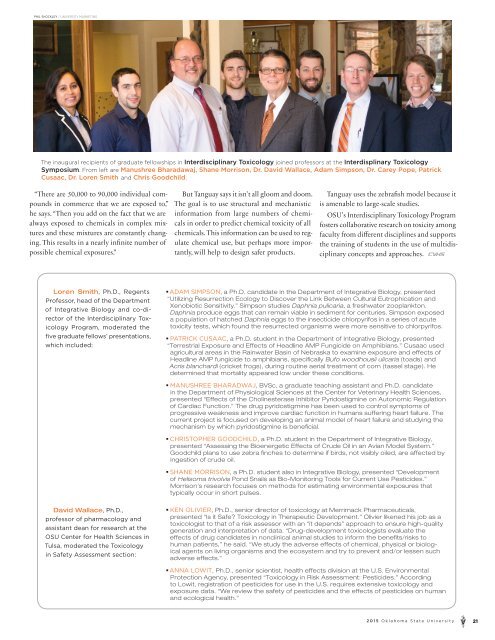Vet Cetera magazine 2015
Official magazine of the Center for Veterinary Health Sciences at Oklahoma State University
Official magazine of the Center for Veterinary Health Sciences at Oklahoma State University
You also want an ePaper? Increase the reach of your titles
YUMPU automatically turns print PDFs into web optimized ePapers that Google loves.
PHIL SHOCKLEY / UNIVERSITY MARKETING<br />
The inaugural recipients of graduate fellowships in Interdisciplinary Toxicology joined professors at the Interdisplinary Toxicology<br />
Symposium. From left are Manushree Bharadawaj, Shane Morrison, Dr. David Wallace, Adam Simpson, Dr. Carey Pope, Patrick<br />
Cusaac, Dr. Loren Smith and Chris Goodchild.<br />
“There are 50,000 to 90,000 individual compounds<br />
in commerce that we are exposed to,”<br />
he says. “Then you add on the fact that we are<br />
always exposed to chemicals in complex mixtures<br />
and these mixtures are constantly changing.<br />
This results in a nearly infinite number of<br />
possible chemical exposures.”<br />
But Tanguay says it isn’t all gloom and doom.<br />
The goal is to use structural and mechanistic<br />
information from large numbers of chemicals<br />
in order to predict chemical toxicity of all<br />
chemicals. This information can be used to regulate<br />
chemical use, but perhaps more importantly,<br />
will help to design safer products.<br />
Tanguay uses the zebrafish model because it<br />
is amenable to large-scale studies.<br />
OSU’s Interdisciplinary Toxicology Program<br />
fosters collaborative research on toxicity among<br />
faculty from different disciplines and supports<br />
the training of students in the use of multidisciplinary<br />
concepts and approaches.<br />
Loren Smith, Ph.D., Regents<br />
Professor, head of the Department<br />
of Integrative Biology and co-director<br />
of the Interdisciplinary Toxicology<br />
Program, moderated the<br />
five graduate fellows’ presentations,<br />
which included:<br />
•ADAM SIMPSON, a Ph.D. candidate in the Department of Integrative Biology, presented<br />
“Utilizing Resurrection Ecology to Discover the Link Between Cultural Eutrophication and<br />
Xenobiotic Sensitivity.” Simpson studies Daphnia pulicaria, a freshwater zooplankton.<br />
Daphnia produce eggs that can remain viable in sediment for centuries. Simpson exposed<br />
a population of hatched Daphnia eggs to the insecticide chlorpyrifos in a series of acute<br />
toxicity tests, which found the resurrected organisms were more sensitive to chlorpyrifos.<br />
• PATRICK CUSAAC, a Ph.D. student in the Department of Integrative Biology, presented<br />
“Terrestrial Exposure and Effects of Headline AMP Fungicide on Amphibians.” Cusaac used<br />
agricultural areas in the Rainwater Basin of Nebraska to examine exposure and effects of<br />
Headline AMP fungicide to amphibians, specifically Bufo woodhousii ulicaria (toads) and<br />
Acris blanchardi (cricket frogs), during routine aerial treatment of corn (tassel stage). He<br />
determined that mortality appeared low under these conditions.<br />
• MANUSHREE BHARADWAJ, BVSc, a graduate teaching assistant and Ph.D. candidate<br />
in the Department of Physiological Sciences at the Center for <strong>Vet</strong>erinary Health Sciences,<br />
presented “Effects of the Cholinesterase Inhibitor Pyridostigmine on Autonomic Regulation<br />
of Cardiac Function.” The drug pyridostigmine has been used to control symptoms of<br />
progressive weakness and improve cardiac function in humans suffering heart failure. The<br />
current project is focused on developing an animal model of heart failure and studying the<br />
mechanism by which pyridostigmine is beneficial.<br />
• CHRISTOPHER GOODCHILD, a Ph.D. student in the Department of Integrative Biology,<br />
presented “Assessing the Bioenergetic Effects of Crude Oil in an Avian Model System.”<br />
Goodchild plans to use zebra finches to determine if birds, not visibly oiled, are affected by<br />
ingestion of crude oil.<br />
• SHANE MORRISON, a Ph.D. student also in Integrative Biology, presented “Development<br />
of Helisoma trivolvis Pond Snails as Bio-Monitoring Tools for Current Use Pesticides.”<br />
Morrison’s research focuses on methods for estimating environmental exposures that<br />
typically occur in short pulses.<br />
David Wallace, Ph.D.,<br />
professor of pharmacology and<br />
assistant dean for research at the<br />
OSU Center for Health Sciences in<br />
Tulsa, moderated the Toxicology<br />
in Safety Assessment section:<br />
• KEN OLIVIER, Ph.D., senior director of toxicology at Merrimack Pharmaceuticals,<br />
presented “Is it Safe? Toxicology in Therapeutic Development.” Olivier likened his job as a<br />
toxicologist to that of a risk assessor with an “it depends” approach to ensure high-quality<br />
generation and interpretation of data. “Drug-development toxicologists evaluate the<br />
effects of drug candidates in nonclinical animal studies to inform the benefits/risks to<br />
human patients,” he said. “We study the adverse effects of chemical, physical or biological<br />
agents on living organisms and the ecosystem and try to prevent and/or lessen such<br />
adverse effects.”<br />
•ANNA LOWIT, Ph.D., senior scientist, health effects division at the U.S. Environmental<br />
Protection Agency, presented “Toxicology in Risk Assessment: Pesticides.” According<br />
to Lowit, registration of pesticides for use in the U.S. requires extensive toxicology and<br />
exposure data. “We review the safety of pesticides and the effects of pesticides on human<br />
and ecological health.”<br />
<strong>2015</strong> Oklahoma State University 21


